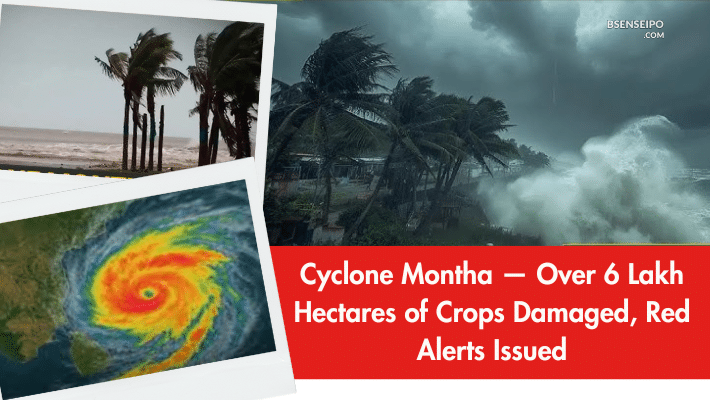Cyclone Montha: Damage Assessment & States Under Red Alert
The severe cyclonic storm named Cyclone Montha advanced across the Bay of Bengal and made landfall along the eastern coast of India around the evening of 28 October 2025, near the coast of Kakinada in Andhra Pradesh. The India Meteorological Department (IMD) issued red alerts in multiple states for extremely heavy rainfall and gusty winds ahead of landfall.
Damage & Impact
While comprehensive, final damage assessments are still being compiled, early government reports and media outlets indicate significant losses:
- In Andhra Pradesh, standing crops across 38,000 hectares have been damaged, and horticulture crops over 1.38 lakh hectares are reported affected.
- The state’s agriculture department also warned that up to around 6.32 lakh hectares of farmland (paddy, cotton etc) could face damage.
- In neighbouring states such as Odisha and Telangana, heavy rains, uprooted trees, power-line damage and landslides have been reported. For example, in Odisha over 50 incident reports (fallen trees, road blockages) were logged by the Fire & Emergency Services.
- Two deaths have been confirmed in Andhra Pradesh due to the cyclone’s impact (one tree‐falling incident) as per the Chief Minister’s office.
- Infrastructure disruptions: rail service cancellations (~160 trains in Andhra shell) and power outages in certain districts.
States & Districts Under Red Alert
Below is a summary of where red alerts (i.e., warnings of extremely heavy rainfall, often >20 cm in 24 h) have been issued:
- Andhra Pradesh: Coastal districts such as Vizianagaram, Visakhapatnam, Anakapalli, Kakinada, Dr BR Ambedkar Konaseema, West Godavari are under red alert.
- Odisha: Southern districts such as Malkangiri, Koraput, Rayagada, Gajapati, Ganjam have red alerts for extremely heavy rainfall.
- Telangana: Some interior districts (e.g., Warangal, Hanumakonda, Mahabubabad, Yadadri Bhuvanagiri, Rajanna Sircilla, Karimnagar) have red alerts for heavy to very heavy rainfall and gusty winds.
- Other states: While not all under red alert, states like Tamil Nadu, Maharashtra’s Vidarbha region have been placed under orange or yellow alerts for heavy rainfall due to outer bands of the cyclone.
Why the Alerts & Damage Are Significant
- The cyclone was forecast to bring wind speeds up to 90-110 km/h (gusting higher) at landfall.
- The coastal state’s low-lying areas, river-banks, and farmland are especially vulnerable to storm surge, flooding, and high sea waves (2-4.7 metres) along the coast.
- The fact that large swathes of agricultural land were already standing (harvest/ready for harvest) makes crop damage high.
- Disruptions to power, transport, and communications hamper relief and damage assessment, increasing potential losses.
What Next & Outlook
- Governments are still compiling full damage estimates (property, infrastructure, private losses).
- Relief measures underway: evacuations (>38,000 in Andhra Pradesh, 32,000+ in Odisha) and setting up thousands of relief camps.
- Agricultural compensation and restoration will be a major focus given the large crop losses.
- Longer-term monitoring will be needed for cyclone’s knock-on effects: soil salinity from seawater intrusion, delayed harvests, market price effects for crops, and rebuilding infrastructure.
Key Takeaway
Cyclone Montha has caused significant early damage, particularly in Andhra Pradesh’s agriculture sector, and major parts of Andhra, Odisha and Telangana are under red alert. While loss of life appears limited to date thanks to proactive evacuations and preparations, the economic impact (crops, infrastructure, services) could be sizable, and recovery efforts will be crucial in the coming days.




